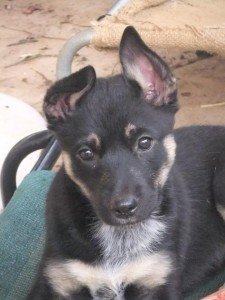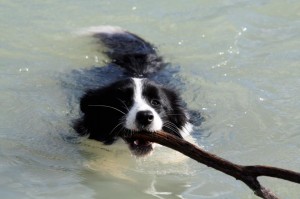The Range of Imitation in Dogs
![]() This is a brief review of the extensive work by German researcher Friederike Range, looking at imitation or modelling behaviour in dogs. Previously, I posted anecdotal evidence on modelling in dogs (which many people shared their experiences on). This post is more sciencey!
This is a brief review of the extensive work by German researcher Friederike Range, looking at imitation or modelling behaviour in dogs. Previously, I posted anecdotal evidence on modelling in dogs (which many people shared their experiences on). This post is more sciencey!

Dogs can imitate the behaviour of both dogs and people. Imitation success depends on a range of factors, including:
- The task at hand, including its complexity, has a role in imitation.
- If a human is modelling the behaviour, if they are talking, this can either help or hinder the dog’s modelling, depending on the task. Eye contact can also help (or hinder) a dog in a task. It can help, as it may illustrate to the dogs bits that it should pay particular attention to. However, it make hinder as it may distract the dog from the task at hand.
- Training plays a role. Dogs that are ‘better trained’ are better at making deduction on behaviour from witnessing a model.
- The dog’s individual personality.
Interestingly, dogs don’t ‘blindly model’ behaviour of other dogs. They will try to be more efficient, they will learn from the other model’s mistakes, and make adjustments based on particular circumstances. For example, if a dog witnesses the model dog carrying a ball and pushing a lever with its foot, the dog will imitate by pushing the lever with its mouth. The dog seems to realise the model dog used its foot because its mouth was occupied. However, if the model dog pushed the lever with its foot without anything in his mouth, the dog will imitate the foot-push. (Almost, the dog imitates superstitious behaviours.)
Fascinatingly, several dogs have been trained to imitate behaviour. A dog called Joy was trained with the cue ‘Do it!’. The experimenter would do one of eight behaviours, say ‘do it’, and Joy would then do the behaviour just demonstrated. After several weeks, they then asked Joy to ‘do’ a behaviour that the experimenter had never demonstrated behaviour. Joy did it. Joy understood the concept of ‘do what I do’. You can see more videos of dogs ‘doing it’.
The conclusions are: Yes, of course dogs model the behaviour of people and dogs. Indeed, they can be trained to do so. There is still a lot of research going on about all the facets of imitation, and it’s all truly fascinating. Definitely a space to watch.
Links of Interest
Do dogs imitate? by Patricia McConnell.
Dogs show human-like learning ability.
If you’re aggressive, your dog probably will be to.
Dogs automatically imitate people.
References
Huber, L, Range, F, Viranyi, Z & Voelkl, B 2008, ‘The evolution of imitation: Old wine in new bottles?’ (PDF).
Range, F., Heucke, S., Gruber, C., Konz, A., Huber, L., & Virányi, Z. (2009). The effect of ostensive cues on dogs’ performance in a manipulative social learning task Applied Animal Behaviour Science, 120 (3-4), 170-178 DOI: 10.1016/j.applanim.2009.05.012
Range, F., & Viranyi, Z. (2009). Different aspects of social learning in dogs Journal of Veterinary Behavior: Clinical Applications and Research, 4 (6) DOI: 10.1016/j.jveb.2009.05.007
Range, F., Viranyi, Z., & Huber, L. (2007). Selective Imitation in Domestic Dogs Current Biology, 17 (10), 868-872 DOI: 10.1016/j.cub.2007.04.026
Szucsich, A, Range, F, Miklosi, A, Huber, L 2008, ‘Imitative ability of dogs‘.
Tiefenthaler, M, Range, F, & Huber, L 2008, ‘Personality in dogs and its influence on social learning behaviour‘.
Virányi, Z., & Range, F. (2009). How does ostensive communication influence social learning in dogs? Journal of Veterinary Behavior: Clinical Applications and Research, 4 (2) DOI: 10.1016/j.jveb.2008.10.023
Viranyi, Z, Range, F, & Huber L 2008, ‘The influence of ostensive demonstration on selective imitation in dogs‘.



